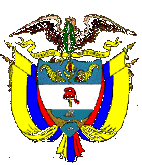Colombia

Geography - People & Population - Government ; Administrative Divisions - Economy
Geography
Location:
Colombia occupies the northwestern end of South America, bordering the Caribbean Sea, between Panama and Venezuela, and bordering the North Pacific Ocean, between Ecuador and Panama. It's the only country in South America with coast-lines on both the Pacific (1,350 km long), and the Atlantic (1600 km long) -- 4 35' 56" N, 74 04' 51" W.
Total Area: 1,141,748 sq km (440,831 sq mi). It is the fourth largest country in South America.
Climate:
Tropical along coast and eastern plains; cooler and cold in highlands. Elevation is the decisive climatic factor.
Terrain:
Flat coastal lowlands, central highlands, high Andes Mountains, eastern lowland plains (a huge open savannah on the north, and the amazon in the south).
Mountains:
Three Andean ranges run north and south through the western half of the country. They dominate the western two-fifths of the country.
Highest point: Cristobal Colon Peak 5,775 m (18,947 ft).
Major rivers:
The major rivers, the Cauca and Magdalena, run through the valleys on either side of the central Andean range (Cordillera Central).
Islands:
Archipelago of San Andres and Providencia in the Caribbean Sea, the Islas del Rosario and San Bernardo along the Caribbean coast,and Gorgona and Malpelo in the Pacific Ocean.
People
Population: 38,100,000 (January 1998 est.)
Population growth rate: 1.65% (1997 est.)
Density: 33.3 persons per sq km.
Distribution 70% urban, 30% rural
Life expectancy at birth: Total population: 73 years
male: 70 years
female: 76 years
Ethnic divisions: mestizo 58%, white 20%, mulatto 14%, black 4%, mixed black-Indian 3%, Indian 1%
Religions: Roman Catholic 95%
Languages: Spanish. In the islands of San Andres and Providencia English is also spoken.
Literacy total population: 91.3% of adult population
Government
Official Name of country: Republic of Colombia
Type of government: Republic; executive branch dominates government structure.
Legislative branch: Bicameral Congress consists of the Senate and House of Representatives
Chief of State and Head of government: President - Andrés Pastrana Arango (1998-2002)
Capital: Santafe de Bogota, D.C. -- Population: 6,600,000
Major cities: Medellin, Cali, Barranquilla, Cartagena, Bucaramanga
Administrative divisions:
32 departments and 1 capital district*; Amazonas, Antioquia, Arauca, Atlantico, Bolivar, Boyaca, Caldas, Caqueta, Casanare, Cauca, Cesar, Choco, Cordoba, Cundinamarca, Guainia, Guaviare, Huila, La Guajira, Magdalena, Meta, Narino, Norte de Santander, Putumayo, Quindio, Risaralda, San Andres y Providencia, Santafe de Bogota*, Santander, Sucre, Tolima, Valle del Cauca, Vaupes, Vichada
Principal national holidays: Independence Day, 20 July (1810). Battle of Boyaca, August 7
Transport:
Airports: 74. International airports: 7. Roads: 115,000 km total. Railroads: 3,386 km total. Major ports: 7.
Economy
Overview:
Colombia has enjoyed one of the Latin America's most consistent record of growth over the last several decades. Growth rates remain high by Latin American standards. Gross domestic product (GDP) has expanded every year for more than 25 years, and unlike many other South American countries, Colombia did not default on any of its official debts during the " lost decade" of the 1980s.
Since 1990, when Bogota introduced a comprehensive reform program that opened the economy to foreign trade and investment, GDP growth has averaged more than 4% annually. The rapid development of oil, coal, and other non-traditional industries in recent years has helped to offset the decline in coffee prices, Colombia's major export.
Gross Domestic Product US$56 billion
Gross Domestic Product composition by sector:
Agriculture: 22% -- Industry: 29% -- Services: 49%
National Product per Capita: US$1,500
Inflation rate (consumer prices): 17.68% (1997)
Labor force: 13.7 million
Industries:
Textiles, food processing, oil, clothing and footwear, beverages, chemicals, metal products, cement; mining - gold, coal, emeralds, iron, nickel, silver, salt.
Industrial production growth rate: 3.5%
Agriculture:
Coffee, cut flowers, bananas, rice, tobacco, corn, sugar cane, cocoa beans, oilseed, vegetables; forest products; shrimp farming
Natural resources: Petroleum, natural gas, coal, gold, emeralds, platinum, iron ore, nickel, copper.
Exports: US$ 8.0 billion
Commodities: Petroleum, coffee, coal, bananas, fresh cut flowers
Partners: US 39%, EC 25.7%, Japan 2.9%, Venezuela 8.5%
Imports: $7.0 billion
commodities: Industrial equipment, transportation equipment, consumer goods, chemicals, paper products
Principal partners:
United States 36%, European Community 18%, Japan 8.7%, Venezuela 6.5%, Brazil 4% (1992)
External Debt: US$17 billion
International Reserve: US$387 billion
Local Currency: 1 Colombian peso (Col$) = 100 centavos
Exchange rates: Colombian pesos (Col$) per US$1 - 1,500 (September 1998)
Next page is in Spanish only, en espanol, but the one after has some pics from Colombia ,so go and check them out